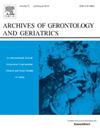通过生物信息学和机器学习识别信号蛋白3C作为肌肉减少症和冠状动脉疾病的生物标志物。
IF 3.5
3区 医学
Q2 GERIATRICS & GERONTOLOGY
引用次数: 0
摘要
目的:肌少症不仅影响患者的生活质量,还可能加重冠心病的病理过程。本研究旨在确定潜在的生物标志物,以改善肌肉减少症和CAD的联合诊断和治疗。方法:肌肉减少症和CAD的数据集来自基因表达综合数据库(GEO)。采用加权基因共表达网络分析(WGCNA)识别关键模块基因。进行功能富集分析,探讨其生物学意义。采用SVM-RFE、LASSO回归和随机森林(random forest, RF)三种机器学习算法进一步确定候选中枢基因。然后,我们生成受试者工作特征(ROC)曲线来评估候选基因的诊断效果。此外,基于GWAS汇总数据进行孟德尔随机化(MR)分析,并进行敏感性分析以探讨因果关系。结果:WGCNA分析鉴定出278个与肌肉减少症和CAD相关的基因。富集分析结果表明,RNA代谢、信号通路和细胞应激反应之间存在复杂的相互作用。通过机器学习方法和ROC曲线,我们确定了关键基因信号蛋白3C (SEMA3C)。MR分析显示,血浆中SEMA3C水平升高与CAD风险增加(OR = 1.068, 95% CI 1.012-1.128, P = 0.016)和手部握力(HGS)降低(OR = 1.059, 95% CI 1.010-1.110, P = 0.018)相关。结论:SEMA3C是肌少症和CAD的关键基因。这一发现表明,靶向SEMA3C可能为相关疾病提供新的治疗机会。本文章由计算机程序翻译,如有差异,请以英文原文为准。
Identifying semaphorin 3C as a biomarker for sarcopenia and coronary artery disease via bioinformatics and machine learning
Objective
Sarcopenia not only affects patients' quality of life but also may exacerbate the pathological processes of coronary artery disease (CAD). This study aimed to identify potential biomarkers to improve the combined diagnosis and treatment of sarcopenia and CAD.
Methods
Datasets for sarcopenia and CAD were sourced from the Gene Expression Omnibus (GEO). Weighted gene co-expression network analysis (WGCNA) was used to identify key module genes. Functional enrichment analysis was conducted to explore biological significance. Three machine learning algorithms were applied to further determine candidate hub genes, including SVM-RFE, LASSO regression, and random forest (RF). Then, we generated receiver operating characteristic (ROC) curves to evaluate the diagnostic efficacy of the candidate genes. Moreover, mendelian randomization (MR) analysis was conducted based on GWAS summary data, along with sensitivity analysis to explore causal relationships.
Results
WGCNA analysis identified 278 genes associated with sarcopenia and CAD. The results of the enrichment analysis indicated a complex interplay between RNA metabolism, signaling pathways, and cellular stress responses. Through machine learning methods and ROC curves, we identified the key gene semaphorin 3C (SEMA3C). MR analysis revealed that higher plasma levels of SEMA3C are associated with an increased risk of CAD (OR = 1.068, 95 % CI 1.012—1.128, P = 0.016) and low hand grip strength (HGS) (OR = 1.059, 95 % CI 1.010—1.110, P = 0.018) .
Conclusion
SEMA3C has been identified as a key gene for sarcopenia and CAD. This insight suggests that targeting SEMA3C may offer new therapeutic opportunities in related conditions.
求助全文
通过发布文献求助,成功后即可免费获取论文全文。
去求助
来源期刊
CiteScore
7.30
自引率
5.00%
发文量
198
审稿时长
16 days
期刊介绍:
Archives of Gerontology and Geriatrics provides a medium for the publication of papers from the fields of experimental gerontology and clinical and social geriatrics. The principal aim of the journal is to facilitate the exchange of information between specialists in these three fields of gerontological research. Experimental papers dealing with the basic mechanisms of aging at molecular, cellular, tissue or organ levels will be published.
Clinical papers will be accepted if they provide sufficiently new information or are of fundamental importance for the knowledge of human aging. Purely descriptive clinical papers will be accepted only if the results permit further interpretation. Papers dealing with anti-aging pharmacological preparations in humans are welcome. Papers on the social aspects of geriatrics will be accepted if they are of general interest regarding the epidemiology of aging and the efficiency and working methods of the social organizations for the health care of the elderly.

 求助内容:
求助内容: 应助结果提醒方式:
应助结果提醒方式:


